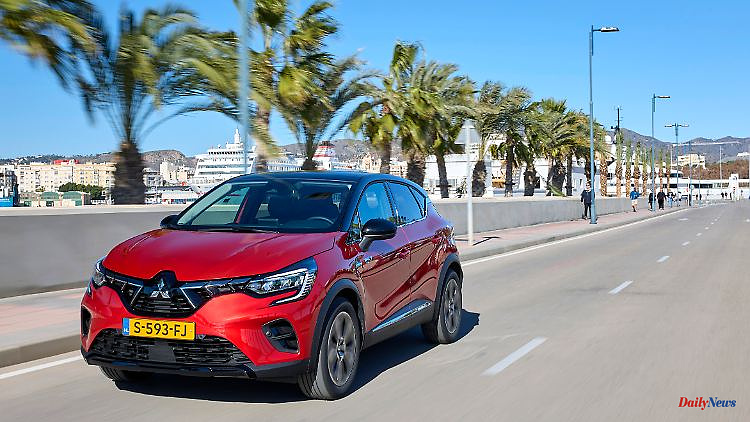In March, Mitsubishi launches the new generation of its ASX. Because time is of the essence for the European market, the Japanese are hurrying to use sister company Renault. Under the sheet metal of the ASX is a friend.
Sometimes things don't go as planned, especially in the automotive industry. In 2020 Mitsubishi had announced that it would not develop any further models for Europe. The high costs and the expected quantities did not go together. Not exactly the best conditions for consolidating a brand, for keeping dealers and customers loyal. At that time, the model portfolio consisted of the small car Space Star, the small SUV ASX, the slightly larger Eclipse and the top model Outlander. ASX and Outlander were discontinued two years ago.
Now, however, Mitsubishi wants to pick up speed again in Europe. The reason is the technical backing of the Renault-Nissan alliance, into which Mitsubishi was integrated back in 2016. This means that even the smallest can help themselves from the large group shelf, which saves a lot of money and puts a new model on a healthy financial footing.
The new ASX is the first. The SUV in the B segment will go on sale in March and starts at 24,650 euros. If you look closely, you think you've seen the design somewhere in a similar form. You can't go wrong with that. The ASX is more or less a copy of the Renault Captur. Which doesn't have to be bad, the little Frenchman is one of the bestsellers in the segment.
Such an approach is not new. Even a Skoda Citigo and a Seat Mii are nothing more than a VW Up!. This not only saves money, but above all a lot of development time. Otherwise Mitsubishi would not have gotten its ASX on the road so quickly. And hurry was required in order not to let the dry spell get any longer.
The Japanese will offer the ASX with five different drives, except for the basic three-cylinder version, all are electrified, ranging from mild to full to plug-in hybrids. We tested the latter on a first tour in southern Spain.
It would be presumptuous to say that the ASX performs differently than the Captur. The tuning of chassis and steering does not differ. The ASX also spoils you with its peace and comfort. Of course, this is particularly pronounced in electric driving mode. If everything runs optimally, the battery capacity (10.5 kWh) in the city is enough for about 64 kilometers, it should be 40 in the mix. At that point at the latest, the combustion engine switches on - and this very discreetly so as not to impair the overall comfort. Even if a lot of power is called up spontaneously, the 1.6-litre petrol engine with its 68 kW/92 hp comes into play.
If you don't travel more than 40 to 50 kilometers a day - the typical commuter distance - and have a wall box at home or at work, you can drive the ASX completely electrically during the week. Longer distances are then covered conventionally by the petrol engine, with the electric motor (49 kW/67 hp) helping to accelerate even when the battery is almost empty. The system performance is quite ample 117 kW/159 hp.
Inside, the ASX offers good space. Adults can also sit comfortably in the rear. The rear seat can even be moved (16 centimetres), depending on whether you want more luggage or more legroom. The trunk holds just 221 liters, a tribute to the large battery in the rear. However, the volume is completely sufficient for everyday use. If you fold down the rear seat backs, the cargo volume increases to 1118 liters. The base petrol engine offers the most luggage space, with 351 or 1275 liters.
The usual digital car world stretches behind the steering wheel, identical to that found in the Renault. A large, vertically oriented touchscreen dominates in the center of the dashboard. If you don't feel like operating buttons, you can activate voice recognition on the steering wheel. Siri from Apple or Google Assistant can also be used and brought into the car via the smartphone.
When it comes to assistance systems, the ASX benefits from the modern Group platform CMF-B - they already use Renault Clio, Captur and Nissan Juke - so that, depending on the equipment, pretty much everything that is common in the class today is on board. These include not only collision warning, pedestrian detection, emergency braking, distance control, lane keeping, reading signs, parking sensors and reversing camera, but also blind spot warning, automatic high beam and the MI Pilot system, which combines adaptive cruise control including active lane following, ideal for example in sluggish and boring freeway traffic.
As pleasant as the overall impression left by the plug-in hybrid variant is, this engine is also by far the most expensive in the ASX range. It's almost 40,000 euros. On top of that, the buyer will no longer receive any funding (environmental bonus) this year. It's worth taking a look at the normal ASX hybrid, which can only drive a few kilometers purely on electricity, but very often enjoys electrical support (boost). This not only saves fuel (4.7 liters standard consumption), but also a chunk of money in the purchase. It is exactly 8400 euros.
Mitsubishi ASX PHEV - specifications
Other engines












